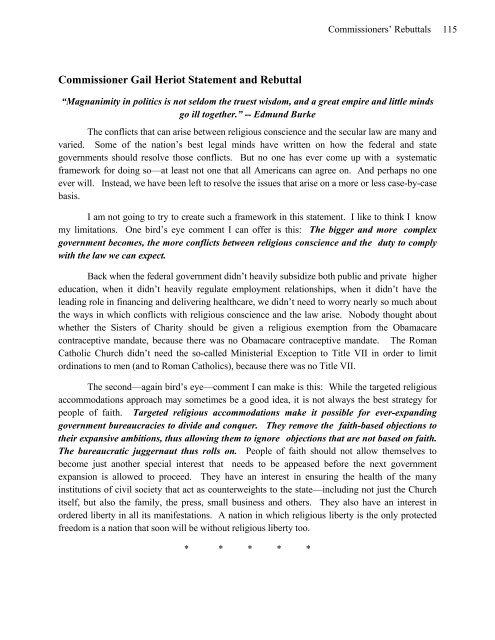PEACEFUL COEXISTENCE
2cgDkdT
2cgDkdT
Create successful ePaper yourself
Turn your PDF publications into a flip-book with our unique Google optimized e-Paper software.
Commissioners’ Rebuttals<br />
117<br />
narrowly as applicable law requires.” We’d still be in the position of having to figure out whether<br />
applicable law does indeed or should require any such thing.<br />
Recommendation #2 states:<br />
“RFRA protects only religious practitioners’ First Amendment free exercise rights,<br />
and it does not limit others’ freedom from government-imposed religious<br />
limitations under the Establishment Clause.”<br />
If you are having trouble figuring out what Recommendation #2 is trying to get at, you are<br />
not alone. Perhaps it is trying to say that Congress, in attempting to protect the religious liberty of<br />
some, must take care not to violate the Constitution’s Establishment Clause, which prohibits “any<br />
law respecting an establishment of religion.” If so, again, yes, of course. But, again, the difficulty<br />
is in the details. Everybody with even a passing understanding of the Constitution knows that<br />
Congress must steer a path between the Free Exercise Clause and the Establishment Clause. 2<br />
How to do that is not so easy; volumes have been written on it. Yet a simple, foolproof technique<br />
for doing so has never been discovered and perhaps never will be, since cases continue to reach<br />
the Supreme Court in need of resolution. This report does nothing to help resolve those issues.<br />
Recommendation #3 states:<br />
“In the absence of controlling authority to the contrary such as a state-level,<br />
RFRA-style statute, the recognition of religious exemptions to nondiscrimination<br />
laws and policies should be made pursuant to the holding of Employment Division<br />
v. Smith, which protects religious beliefs rather than conduct.”<br />
Two things: First, like some of the other recommendations, this one is worded in such a<br />
way as to sound significant, but in the end it doesn’t mean much. It states that in the absence of<br />
law pointing in the other direction one should apply Smith. But often there is authority pointing<br />
in the other direction (and when there isn’t, the legislature may create such a law). It can come<br />
not only from RFRA-style statutes, but also from state constitutions, whose religious liberty<br />
guarantees may be very different from the Free Exercise Clause of the U.S. Constitution as<br />
interpreted in Smith. It can also come from the nondiscrimination statutes themselves, in the form<br />
of an explicit or implicit requirement for religious accommodation (or in the form of broader<br />
exceptions into which religious accommodations may fit). For example, Title VII forbids sex<br />
discrimination in employment, but contains an exception for “bona fide occupational<br />
qualifications based on sex.” Might such a provision permit a specialty restaurateur whose<br />
religion forbids his co-religionists from eating food prepared by women to hire only men? The<br />
Commission’s recommendation surely provides us with no assistance in answering that question.<br />
2<br />
For example, if the federal government funds religious schools, is it a violation of the Establishment Clause? Or is it<br />
a violation of the Free Exercise Clause to fund all schools, except religious schools?


